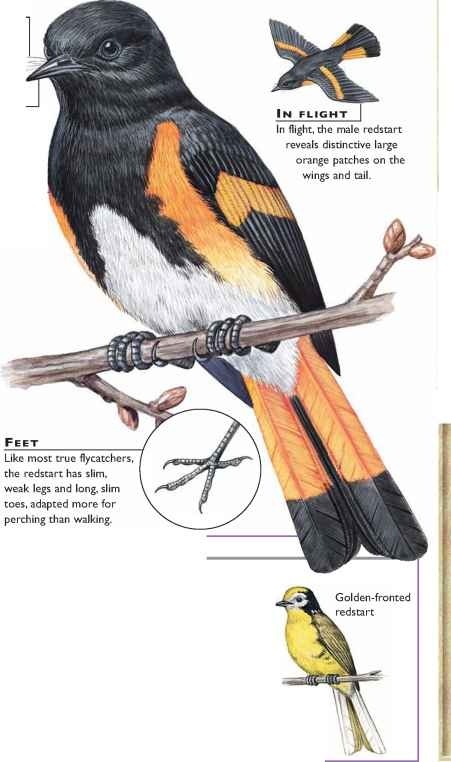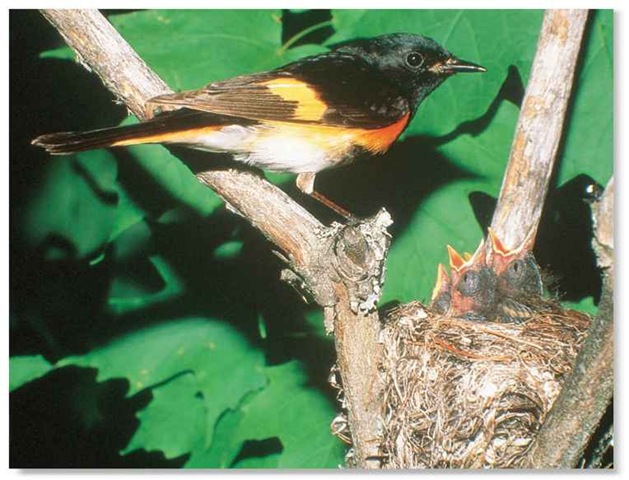ORDER
Passeriformes
FAMILY
Parulidae
GENUS & SPECIES
KEY FEATURES
Flicks tail conspicuously when chasing insects Resembles a black-and-orange butterfly as it flutters between tree branches Droops its wing and fans its tail in display One of the most common American wood warblers nesting in North America
WHERE IN THE WORLD?
Found throughout North America in parts of Canada and the U.S.; winters in central and South America and the West indies

Lifecycle
The solitary American redstart performs aerial rushes for display and defense and devours insects in midair during feeding frenzies in the forest.
HABITAT-
The American redstart lives in a variety of habitats: it frequents deciduous and tropical forests, mangroves, savannahs, suburban areas and mixed forests. In winter; the redstart migrates to light woodlands and scrub habitats from the southern U.S. to South America and also in
Jamaica. In Venezuela, adult male redstarts are found in forests, while females and young males prefer mangroves.
Forest hideaway Only the redstart’s eyes and tail are visible as it peers from its deep nest.
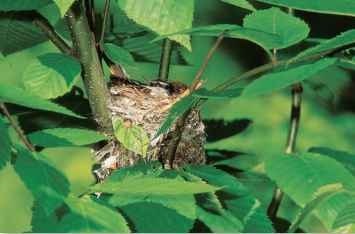
When incubating, the American redstart turns the eggs once every 8 minutes. This ensures that there is equal heating throughout the eggs and prevents embryonic membranes from sticking to the inner surface of the shell.
The redstart is one of the most common victims of the cowbird, which lays its eggs in the redstart’s nest. The cowbird chicks are then raised by the redstart.
Latin Americans refer to the redstart as candelita, or little torch, because of its flashes of red and orange.
BREEDING
American redstarts leave their winter home in Central and South America and the West Indies in March, heading north to breeding grounds ranging from Alaska to Georgia. Males arrive first and stake out territories, usually less than 1 acre in size. A male defends his area through warning chirps and aerial displays. During courtship, he raises his wings and holds them perpendicular to the ground, and spreads his tail feathers to show his bold orange-red plumage, a symbol of his maturity. Males also court females by bringing them food. The female builds a nest high in the trees, usually 10-20′ above ground, most often nestled in the crotch of the tree.The nest is a deep cup made mostly of grasses, lined with feathers and material such as deer hair. The female lays 3-5 greenish-white eggs, with small, brown specks, and incubates them alone for 12 days. Both parents feed the young chicks for 8-10 days until they are capable of finding their own food. Fledglings join the adults in
August to begin the migratory journey south. They look like adult females; males will attain adult plumage in two years.
Hungry quartet The four hungry chicks open their mouths wide, begging for food.
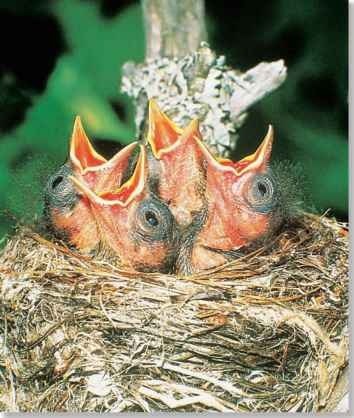
FOOD & FEEDING
The American redstart is constantly on the lookout for its insect prey, frequently hopping between the branches of trees and shrubs in search of beetles and caterpillars. As the day warms and insects become more active, the redstart searches for prey in flight, snatching insects, such as moths and wasps, in midair. It also hovers around foliage to catch flies. Rictal bristles around the mouth protect the bird’s eyes as it captures flying insects. In winter and during migrations the redstart eats seeds and berries, including barberry juneberries and magnolia seeds. The bird’s long, thin bill promotes the quick capture of either plant or animal food.
VIVACIOUS EATERS
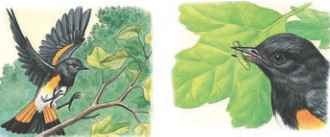
1 Assume the position
A male redstart prepares to land at a choice spot in a bush, perfect for perching and spotting its next insect meal.
2 A short wait
A hungry American redstart spies a small green caterpillar and quickly grabs it with its long, thin bill.
CONSERVATION
The American redstart is common throughout its range. Though abundant in open forests, the number of American redstarts has declined slightly in the last two decades, an indication of cyclical population fluctuation rather than threats posed by humans or predators. The redstart is beneficial to humans, since its diet includes many insects harmful to crops.
BEHAVIOR
The American redstart’s song consists of high, thin notes that produce a pleasant buzzing sound. Although the male is most often heard as he establishes and defends his territory in the spring, females also sing. The redstart is extremely active throughout the year and flits through trees and scrubs as it forages. Usually solitary, the redstart occasionally will form flocks with other species, including white-throated sparrows, during foraging trips on wintering grounds.
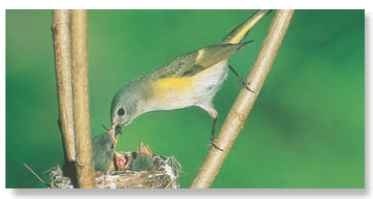

Meal of choice
With speed and skill, a redstart begins its pursuit of a flying insect, which is no match for the bird in an aerial chase.
Saving the best for last
With a firm grasp on its prey, the patient bird returns to its perch, where it savors the large insect in safety.
A cool bath
A female American redstart cleans her feathers.
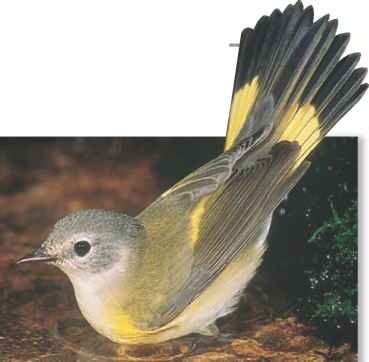
Profile
American Redstart
The American redstart is an agile and diminutive songbird with a long, thin beak, which it uses to capture prey in midair.
Bristles
Rictal bristles around the mouth protect the redstart’s eyes from damage caused by flying insects.
Bill
The redstart uses its thin, pointed bill to snatch insects in flight and glean them from foliage.
Plumage
The male is glossy black with a white belly and patches of orange on its wings, sides and tail.
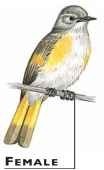
The slightly smaller female has a gray head, olive upperparts and white underparts with yellow patches. The female’s wings may appear worn.
CREATURE COMPARISONS
At 5.5″, the golden-fronted redstart (Myioborus ornatus) resides year-round in South America and is. slightly larger than its American redstart cousin. It has bright yellow underparts, hence its name, in contrast with the American redstart’s white underparts.The golden-fronted redstart lives at altitudes up to 10,000′, mainly in cloud forests in subtropical regions, while the American redstart has adapted to a variety of habitats. Both the golden-fronted redstart and the American redstart forage in trees for insects.
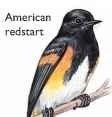
RELATED SPECIES
• The American redstart is the only species in the genus Setophaga. The painted redstart, Myioborus pictus, is a close relative. Redstarts join other American wood warblers, as well as the ovenbird, waterthrushes and yellowthroats, in the family Parulidae. The family contains about 109 species, including the yellow-breasted chat, Icteria virens, the largest American wood warbler.
